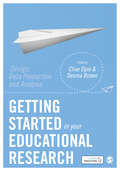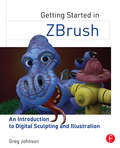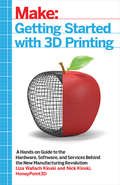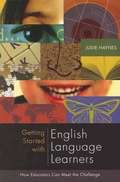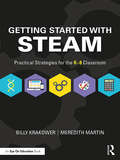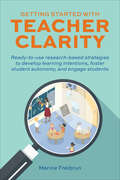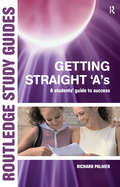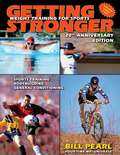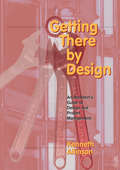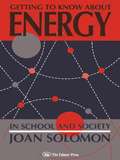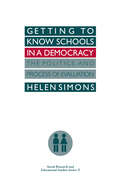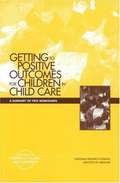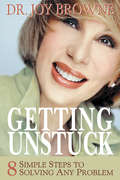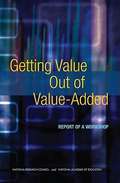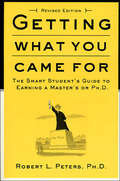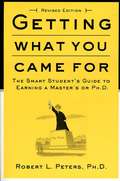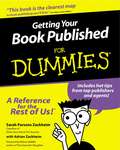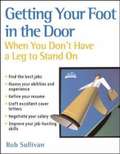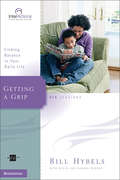- Table View
- List View
Getting Started in Your Educational Research: Design, Data Production and Analysis
by Clive Opie Desma BrownA one-stop shop for anyone undertaking educational research for the first time, this text focuses on the development and application of key skills necessary for successful research. Packed with useful exercises, checklists and case studies, this book will allow the reader to apply their skills across a range of essays, presentations and reports. Using digestible language to explain complex terminology and processes simply, the authors explore working with and presenting data and the software options available to students, including NVivo, SPSS and Excel. The text will help students to: Understand the language of educational research Frame their research questions and design their research Judge the quality of educational research Explore and justify research approaches and procedures (methods) Analyse and present their data
Getting Started in ZBrush: An Introduction to Digital Sculpting and Illustration
by Greg JohnsonGetting Started in ZBrush is a gentle introduction to ZBrush, today’s premier digital sculpting program. Beginning with the fundamentals of digital sculpting as well as a thorough introduction to the user interface, Getting Started in ZBrush will have you creating a variety of professional-level 3D models in no-time. More than just another button-pushing manual, this comprehensive guide is packed with start-to-finish projects that ease you into the workflow of the program, while at the same time providing tips and tricks that will allow you to achieve certain tasks much more quickly. After progressing through the tutorials, you will be shown how to customize brushes, materials, scripts, and the interface so that you can utilize these tools to their full advantage. Special consideration is given to ZBrush’s integration plug-ins with Maya and 3ds Max, allowing you to properly import and export your models in all programs. Texturing, painting, mapping, decimation, baking, and topology are also fully covered so your Zbrush creations can come to life without sacrificing that high-resolution look. Ease your way into this complex subject with this straight-forward approach to ZBrush Perfect your technique with step-by-step tutorials that allow you to create high res models from start to finish. Expand your knowledge by visiting the companion website, which features video demonstrations, project files, texture and model files, scripts, customized menus, brushes, and additional resources.
Getting Started on Research (The Academic's Support Kit)
by Debbie Epstein Jane Kenway Professor Rebecca BodenGetting Started in Research is for people in the earlier stages of development as a researcher. In contrast to the many books available on techniques of data collection and analysis, this volume deals with the many other practical considerations around actually doing research - such as good ways to frame research questions, how to plan your research projects effectively and how to undertake the various necessary tasks.
Getting Started with 3D Printing: A Hands-on Guide to the Hardware, Software, and Services Behind the New Manufacturing Revolution
by Liza Wallach Kloski Nick KloskiMake: Getting Started with 3D Printing is a practical, informative, and inspiring book that guides readers step-by-step through understanding how this new technology will empower them to take full advantage of all it has to offer. The book includes fundamental topics such as a short history of 3D printing, the best hardware and software choices for consumers, hands-on tutorial exercises the reader can practice for free at home, and how to apply 3D printing in the readers' life and profession. For every maker or would-be maker who is interested, or is confused, or who wants to get started in 3D printing today, this book offers methodical information that can be read, digested, and put into practice immediately!
Getting Started with English Language Learners: How Educators Can Meet the Challenge
by Judie HaynesIn Getting Started with English Language Learners: How Educators Can Meet the Challenge, Judie Haynes provides a practical resource to help educators who are new to the field of English as a Second Language understand the needs of English language learners. From learning how students acquire a second language to differentiating instruction to exploring practical strategies for teaching newcomers, this book will help educators learn how to create effective learning environments for English language learners.
Getting Started with STEAM: Practical Strategies for the K-8 Classroom
by Meredith Martin Billy KrakowerLearn effective ways to teach STEAM with this helpful book from educational technology experts Billy Krakower and Meredith Martin. Whether you have a dedicated STEAM class, or plan to integrate it into a regular classroom, you’ll find out how to create a structured learning environment while still leaving room for inquiry and innovation. You’ll also gain a variety of hands-on activities and rubrics you can use immediately. Topics include: the differences among STEM, STEAM, and makerspaces planning your STEAM space stocking your space with the right supplies planning for instruction and managing class time incorporating the core subjects aligning lessons with standards and assessments getting the administration and community involved taking your class to the next level with design thinking. With this practical book, you’ll have all the tools you’ll need to create a STEAM-friendly learning space starting now. Continue the conversation on Twitter with the hashtag #GSwSTEAM!
Getting Started with Teacher Clarity: Ready-to-Use Research Based Strategies to Develop Learning Intentions, Foster Student Autonomy, and Engage Students
by Marine FreibrunHelp elementary school students engage in the learning process and achieve their goals in the classroom with this effective & proven teaching method.Clear communication between students and teachers is crucial for effective learning. When students understand the why and how of learning (a.k.a. “teacher clarity”), it’s so much easier for them to fully engage with the process and achieve their goals. This book details the benefits that clear communication can have in elementary classroom, from breaking down the basics of teacher clarity and shared learning progressions to providing classroom-ready activities. Plus, you’ll discover suggestions for effective classroom teaching practices, including:Deconstructing state standards to develop learning intentions and objectivesDeveloping success criteria to support new learningBuilding student awareness through structured language talkEmbedding self-assessment checks for students to assess their levels of understanding throughout a lessonAnd much moreThrough the research-based methods of teacher clarity, educators will understand the importance of partnership between students and teachers, which in turn fosters improved student success.
Getting Straight 'A's: A Student's Guide to Success
by Richard PalmerPacked full of invaluable and practical advice, tips, quizzes and self-assessment exercises for fifteen to eighteen year olds, this guide, written with the keenest and most ambitious students in mind, will help you to maximise your academic potenitial and achieve the results you need. Written by an acknowledged expert in the field, this study guide will help you to: assess your own strengths and weaknesses make the best use of available resources effectively manage your time and prioritise your workload develop essay-writing and note-taking skills excel in exams and coursework. Considered a natural companion to the author's highly successful Brain Train, this book maximises academic potential both in coursework and exams amongst GCSE and AS/A-level students, effectively, simply, and without exhausting and counter-productive effort.
Getting Stronger: Weight Training for Sports (20th Anniversary Edition)
by Bill PearlWritten by Bill Pearl, a four-time Mr. Universe, and widely regarded as the best general book on weight training available, Getting Stronger contains specific strength training programs for 21 sports as well as general conditioning. The book includes more than 100 one-page fitness programs that can be performed by simply following the illustrations, while each lift is keyed to a section with specific instructions for that lift. The 20th anniversary edition includes new sections on nutrition, supplements, injury rehabilitation, stretching, and equipment.
Getting The Most Out Of Clinical Training And Supervision: A Guide To Practicum Students And Interns
by Carol A. Falender Edward ShafranskeClinical training is challenging for supervisees, many of whom are unsure how to navigate the supervisory process and effectively build clinical skills and professional competence. While research and book-length texts on effective supervision have proliferated, these are typically directed towards supervisors and clinical educators.
Getting There (Early Reader #2)
by Marla Stewart KonradA picture book collaboration with World Vision that celebrates life the world over!From the moment we take our first steps, it seems we are always on the move. Pictured here are the many and unusual ways we get around. Whether they go on their own two feet, by wheeled vehicle, water craft, animal power, or by air, children find some unorthodox and truly imaginative ways to “get there.”This delightful series is the result of the collaboration between Tundra Books and World Vision Canada to bring an array of exceptional photos from around the world to very young children. Each book centers on a universal theme, familiar by its very nature, yet new due to faraway settings and ethnic, cultural, and socio-economic diversity. Each remarkable photo essay will foster discussion, observation, and many smiles as children compare and contrast their own experience to that of others. Watch for further books in this series.
Getting There by Design
by Kenneth AllinsonThere was military project management. There was construction project management. Then there was business project management, a tool described as 'the wave of the future'. Where are architects in all this, professionals whose work has always been project-driven? There is design management in engineering, product design, graphics, packaging, management theory and even in politics. Construction consultants talk about managing design. When are architects going to become committed to managing design?Getting There by Design adopts an architect's view to design and project management. It sets out the fundamental principles and shows how they are applied, dealing with these two topics as one indivisible subject.'Getting There by Design' demonstrates how to: - make project efforts goal-oriented - set up a planning and monitoring basis to architectural projects - put the architect's fee calculus on a rationale basis - diagnose your firm's practice culture - develop successful teamsPut your practice onto a more effective basis.Ken Allinson is an architect in private practice and principal of 'Architectural Dialogue'. He also teaches design studio and lectures on design and project management. He was formerly an associate at DEGW London and the Terry Farrell Partnership. He has practice experience in Europe, the USA and Japan and is the author of 'The Wild Card of Design' (1993).
Getting To Know About Energy In School And Society
by Joan SolomonFirst published in 1992. Routledge is an imprint of Taylor & Francis, an informa company.
Getting To Know Schools In A Democracy: The Politics And Process Of Evaluation (Social Research And Educational Studies #Vol. 5)
by Helen SimonsFirst published in 1987. Routledge is an imprint of Taylor & Francis, an informa company.
Getting To Maybe: How To Excel On Law School Exams
by Richard Michael Fischl Jeremy PaulETHS graduate in 1970, Fischel has had a successful and quite varied career in law. Here he presents a clear and engaging study-aid designed to get prospective lawyers to quit regurgitating course outlines and to think in terms of legal analysis.
Getting To Positive Outcomes For Children In Child Care: A Summary Of Two Workshops
by Board On Children Families YouthA summary on Getting To Positive Outcomes For Children In Child Care
Getting Unstuck: 8 Simple Steps To Solving Any Problem
by Joy Browne8 Simple Steps to Solving Any Problem! When it comes to problem-solving, Dr. Joy Browne is a pro at not only doing it, but showing you how to do it, too. On her own syndicated radio and television programs, she plays host to millions of listeners whose problems are solved one caller at a time. In this book, she lays out her revolutionary 8-Step Problem-Solving System, making it crystal-clear how to go about finding answers to life challenges. When it comes to finding solutions, Dr. Joy knows that there's no problem too big or too small. Whether you want to overcome your fears, gain perspective and self-awareness, or perfect the fine art of relationships at home or at work, this book has the answers you've been looking for. Dr. Joy Browne will teach you how to quit being your own worst enemy and start being your own best friend, parent, mentor, and shrink all wrapped up in one. Full of timeless wisdom, profound insight, and gentle humor, Getting Unstuck is Dr. Joy's definitive guide to cutting through the psychological red tape that stands between you and the life you want.
Getting Value out of Value-Added: Report of a Workshop
by National Research Council National Academy of EducationValue-added methods refer to efforts to estimate the relative contributions of specific teachers, schools, or programs to student test performance. In recent years, these methods have attracted considerable attention because of their potential applicability for educational accountability, teacher pay-for-performance systems, school and teacher improvement, program evaluation, and research. Value-added methods involve complex statistical models applied to test data of varying quality. Accordingly, there are many technical challenges to ascertaining the degree to which the output of these models provides the desired estimates. Despite a substantial amount of research over the last decade and a half, overcoming these challenges has proven to be very difficult, and many questions remain unanswered--at a time when there is strong interest in implementing value-added models in a variety of settings. The National Research Council and the National Academy of Education held a workshop, summarized in this volume, to help identify areas of emerging consensus and areas of disagreement regarding appropriate uses of value-added methods, in an effort to provide research-based guidance to policy makers who are facing decisions about whether to proceed in this direction.
Getting What You Came For: The Smart Student's Guide to Earning a Master's or a Ph.D.
by Robert L. PetersIs graduate school right for you? Should you get a master's or a Ph.D.? How can you choose the best possible school? This classic guide helps students answer these vital questions and much more. It will also help graduate students finish in less time, for less money, and with less trouble. Based on interviews with career counselors, graduate students, and professors, Getting What You Came For is packed with real-life experiences. It has all the advice a student will need not only to survive but to thrive in graduate school, including: instructions on applying to school and for financial aid; how to excel on qualifying exams; how to manage academic politics—including hostile professors; and how to write and defend a top-notch thesis. Most important, it shows you how to land a job when you graduate.
Getting What You Came For: The Smart Student's Guide to Earning an M.A. or a Ph.D.
by Robert L. PetersIs graduate school right for you? Should you get a master's or a Ph. D. ' How can you choose the best possible school? This classic guide helps students answer these vital questions and much more. It will also help graduate students finish in less time, for less money, and with less trouble. Based on interviews with career counselors, graduate students, and professors,Getting What You Came For is packed with real-life experiences. It has all the advice a student will need not only to survive but to thrive in graduate school, including: instructions on applying to school and for financial aid; how to excel on qualifying exams; how to manage academic politics--including hostile professors; and how to write and defend a top-notch thesis. Most important, it shows you how to land a job when you graduate.
Getting Work Done (20-Minute Manager Series)
by Harvard Business ReviewOverwhelmed by the sheer volume of work you need to accomplish? Being pulled in different directions by competing priorities? Getting Work Done runs you through the basics of being more productive at work. You'll learn to: Align your schedule with your priorities Focus your attention and avoid distractions Create effective daily routines Set boundaries and learn to say noAbout HBR's 20-Minute Manager Series:Don't have much time? Get up to speed fast on the most essential business skills with HBR's 20-Minute Manager series. Whether you need a crash course or a brief refresher, each book in the series is a concise, practical primer that will help you brush up on a key management topic.Advice you can quickly read and apply, for ambitious professionals and aspiring executives-from the most trusted source in business. Also available as an ebook.
Getting Your Book Published For Dummies (For Dummies Ser.)
by Sarah Parsons Zackheim Adrian ZackheimThere’s never been a better time to be an author. Books like the Harry Potter series create a media phenomenon, with people lining up and camping outside bookstores to purchase newly released titles. Yet book sales overall – not just those of mega-sellers – are on the rise, as more and more people seek knowledge and entertainment through reading. The Library of Congress currently registers about 60,000 new titles for copyright each year. 60,000 books by 60,000 authors. Imagine yourself as one. Getting Your Book Published For Dummies is your complete guide to realizing whatever gem of an idea you’ve been carrying with you. If you’ve ever thought, “this would make a really good book,” be it the next great American novel or a guide to naming babies, here’s your chance to put pen to paper and find out! Written from both sides of the editor’s desk – by a widely published writer and a HarperCollins veteran publisher – this guide puts in your hand the advice you need to: Pick an idea Approach the publisher Craft proposals and queries Work with agents, or act as your own Self-publish Negotiate a contract Create the actual book Sell your published book Full of examples, proposals, query letters, and war stories drawn from the authors’ extensive experience, Getting Your Book Published For Dummies shows you how to clear all the hurdles faced by today’s writers – freeing up precious time for you to refine your manuscript. You’ll get the inside scoop on: Titling your book Major publishers, smaller houses, niche publishers, university presses, and spiritual and religious publishers The 12 elements of a successful nonfiction proposal How editors read queries Submitting fiction Publishing outside the box And much more Getting Your Book Published For Dummies is the clear, A-Z handbook that makes the entire process plain and practicable. You don’t need to be a celebrity. You don’t need to be some kind of publishing insider. All you need to do is write.
Getting Your Foot in the Door When You Don't Have a Leg to Stand On
by Robert C. SullivanLooking for a job is intimidating, especially when significant experience is the main thing a job hunter is lacking. In <i>Getting Your Leg in the Door When You Don't Have a Leg to Stand On</i>, the author, a successful headhunter and job-hunting coach, shares insights and techniques that he learned from working with job hunters at all levels. He presents expert advice, case studies, and strategies for getting the interview, then demonstrating the qualities and skills most likely to convince an employer of one's abilities.
Getting Your PhD: A Practical Insider's Guide
by Teela Sanders Harriet Churchill`Getting your PhD will no doubt establish itself as a firm favourite' - ESCalate `Packed with practical advice on all aspects of the PhD process, new and continuing research students should find this book of great help' - Professor Malcolm Tight, Lancaster University, UK How to get your Ph. D is an original study guide aimed at prospective and current postgraduate students, covering the process of accessing, undertaking and completing doctoral research in the social sciences and the humanities. The content is unique in incorporating discussion of the less recognised personal, emotional and organisational demands of independent study. Drawing on a variety of student experiences, the authors apply a case study approach to examine the dilemmas and complexities of postgraduate study. The book is organised into four parts covering the research process; writing, publishing and networking; shifting identities and institutions and relationships of support. Each chapter includes an easy to use format including real-life accounts, tips and strategies for problem solving and guidance for additional resources. The guide includes accessible advice and guidance across a spectrum of methodological, personal, emotional, practical and institutional issues.
Getting a Grip
by Bill Hybels Kevin HarneyHow to gain traction when you’re out of control. If you drive anywhere in the snow belt, you probably know the feeling: rear wheels fishtailing, steering useless, brakes ineffective—you’re out of control. The good news is, life doesn’t have to be like a car on ice. Bill Hybels offers biblical insights and practical steps to securing a Christ-centered life that will get you where you want to go. Getting a Grip guides you toward wise choices and disciplined action in five vital areas of your life: your time, your health, your finances, your spiritual life, and your relationships. As you learn what the Bible has to say about each of these, you’ll discover how able and eager Jesus is to help you obtain solid traction on the road of life. Interactions—a powerful and challenging tool for building deep relationships between you and your group members, and you and God. Interactions is far more than another group Bible study. It's a cutting-edge series designed to help small group participants develop into fully devoted followers of Christ.
